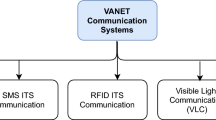Abstract
Vehicular urban sensor network is a new network paradigm for sensing data collection in urban environment. An on-board unit (OBU) is required to transfer data collected from sensors to the back-end server through various wireless networks, such as DSRC/WAVE, cellular networks, WiMAX, and WLAN/Wi-Fi. However, in any of such deployment, OBU should be equipped with an expensive transmitter. After transmitted to the server, those data can be further processed for many applications, such as automated traffic enforcement, Pay-as-You-Drive insurance, electronic toll pricing, and traffic statistics. Such raw data always contains vehicle and driver’s private information. Considering both cost and privacy concerns, we propose a new vehicle urban sensing infrastructure. Instead of deploying an expensive transmitter on OBU, we choose to use smartphone to transfer data through cellular network, which can be communicated with OBU equipped with a cheaper Bluetooth transmitter. To achieve privacy, we design an efficient protocol among OBU, smartphone, and back-end server by using some cryptographic techniques. Compare with the traditional OBU with 3G module (231 USD), the OBU we use is much cheaper (44.6 USD). Our protocol is also efficient enough to be deployed in practice.



Similar content being viewed by others
Notes
Other information such as air pollution level can be collected as well.
References
Arkko J, Rissanen H, Keranen A, Sethi M (2012) Practical considerations and implementation experiences in securing smart object networks
Balasch J, Rial A, Troncoso C, Preneel B, Verbauwhede I, Geuens C (2010) Pretp: privacy-preserving electronic toll pricing. In: USENIX security symposium, pp 63–78
Biswas S, Misic JV (2013) A cross-layer approach to privacy-preserving authentication in WAVE-enabled VANETs. IEEE T Veh Technol 62(5):2182–2192
Boneh D, Boyen X (2004) Short signatures without random oracles. In: EUROCRYPT, volume 3027 of lecture notes in computer science. Springer, pp 56–73
Camenisch J, Chaabouni R, Shelat A (2008) Efficient protocols for set membership and range proofs. In: ASIACRYPT, volume 5350 of lecture notes in computer science. Springer, pp 234–252
Campbell AT, Eisenman SB, Lane ND, Miluzzo E, Peterson RA (2006) People-centric urban sensing. In: ACM Proceedings of the 2nd annual international workshop on wireless internet, pp 1–14
Chen L, Ng S-L, Wang G (2011) Threshold anonymous announcement in VANETs. IEEE J Selected Areas Commun 29(3):605– 615
Chim TW, Yiu SM, Hui LC K, Li V OK (2014) VSPN VANET-based secure and privacy-preserving navigation. IEEE Trans Comput 63(2):510–524
Ferreres AIG-T, Alcaide A, de Fuentes JM, Montero J (2013) Privacy-preserving and accountable on-the-road prosecution of invalid vehicular mandatory authorizations. Ad Hoc Netw 11(8):2693–2709
Huang D, Misra S, Verma M, Xue G (2011) PACP: an efficient pseudonymous authentication-based conditional privacy protocol for VANETs. IEEE Trans Intell Transp Syst 12(3):736–746
Iqbal M U, Lim S (2006) A privacy preserving GPS-based pay-as-you-drive insurance scheme. In: Symposium on GPS/GNSS (IGNSS2006), pp 17–21
Blumberg A J, Keeler L S, Shelat A (2005) Automated traffic enforcement which respects driver privacy. In: IEEE proceedings on intelligent transportation systems, pp 941–946
Jiang D, Taliwal V, Meier A, Holfelder W, Herrtwich R (2006) Design of 5.9 ghz DSRC-based vehicular safety communication. IEEE Wireless Commun 13(5):36–43
Lee U, Gerla M (2010) A survey of urban vehicular sensing platforms. Comput Netw 54(4):527–544
Liu JK, Yuen TH, Au MH, Susilo W (2014) Improvements on an authentication scheme for vehicular sensor networks. Expert Syst Appl 41(5):2559–2564
Lu R, Lin X, Liang X, Shen XS (2012) A dynamic privacy-preserving key management scheme for location-based services in VANETs. IEEE Trans Intell Transp Syst 13(1):127–139
Lu R, Lin X, Luan TH, Liang X, Shen XS (2012) Pseudonym changing at social spots: an effective strategy for location privacy in VANETs. IEEE T Veh Technol 61(1):86–96
Lu R, Lin X, Zhu H, Shen X (2010) An intelligent secure and privacy-preserving parking scheme through vehicular communications. IEEE Trans Veh Technol 59(6):2772–2785
Malandrino F, Borgiattino C, Casetti C, Chiasserini C-F, Fiore M, Sadao R Verification and inference of positions in vehicular networks through anonymous beaconing. IEEE Trans Mob Comput. 13(10):2415–2428
Malandrino F, Casetti CE, Chiasserini C-F, Fiore M, Yokoyama RS, Borgiattino C (2013) A-VIP: anonymous verification and inference of positions in vehicular networks. In: INFOCOM. IEEE, pp 105–109
Meiklejohn S, Mowery K, Checkoway S, Shacham H (2011) The phantom tollbooth: privacy-preserving electronic toll collection in the presence of driver collusion. In: USENIX security symposium, pp 1–16
Popa RA, Balakrishnan H, Blumberg AJ (2009) Vpriv: protecting privacy in location-based vehicular services. In: USENIX security symposium, pp 335–350
Schnorr C-P (1989) Efficient identification and signatures for smart cards. In: Brassard G (ed) CRYPTO, volume 435 of lecture notes in computer science. Springer, pp 239–252
Shim K-A (2012) CPAS: an efficient conditional privacy-preserving authentication scheme for vehicular sensor networks. IEEE T Veh Technol 61(4):1874–1883
Sun Y, Lu R, Lin X, Shen X, Su J (2010) An efficient pseudonymous authentication scheme with strong privacy preservation for vehicular communications. IEEE T Veh Technol 59(7):3589–3603
Troncoso C, Danezis G, Kosta E, Balasch J, Preneel B (2011) Pripayd: privacy-friendly pay-as-you-drive insurance. IEEE Trans Depend Secure Comput 8(5):742–755
Yeh L-Y, Huang J-L PBS: a portable billing scheme with fine-grained access control for service-oriented vehicular networks. IEEE Trans Mob Comput. 13(11):2606–2619
Ying B, Makrakis D, Mouftah HT (2013) Privacy preserving broadcast message authentication protocol for VANETs. J Netw Comput Appl 36(5):1352–1364
Acknowledgement
This work is supported by National Natural Science Foundation of China (No. 61402136), Natural Science Foundation of Guangdong Province, China (No. 2014A030313697), Guangdong Provincial Key Laboratory of High Performance Computing (No. [2013]82).
Author information
Authors and Affiliations
Corresponding author
Rights and permissions
About this article
Cite this article
Zuo, C., Liang, K., Jiang, Z.L. et al. Cost-effective privacy-preserving vehicular urban sensing system. Pers Ubiquit Comput 21, 893–901 (2017). https://doi.org/10.1007/s00779-017-1046-9
Received:
Accepted:
Published:
Issue Date:
DOI: https://doi.org/10.1007/s00779-017-1046-9




